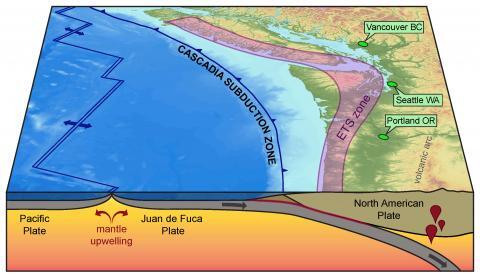
Subduction zones, like this one along the western coast of North America, bring the largest earthquakes that AI can help monitor.
Credit: USGS John Wesley Powell Center for Analysis and Synthesis
Featured Research
New AI tool could help predict earthquakes before they happen
Scientists trained a neural network with a model of subduction zones, areas where tectonic plates are moving beneath each other and where the largest earthquakes happen, known as megathrust earthquakes. The research team used an ‘explainable AI’ which means the AI program runs its test using the models to make forecasts. It then explains to scientists where it focused for its forecasting and why. In this case, the program found that certain areas of tectonic plates moved hours to months before megathrust earthquakes, which could give scientists a better idea of where to prioritize monitoring. While the program cannot forecast earthquakes on its own yet, it can help researchers potentially better their own forecasting. [Geophysical Research Letter study]
Model of climate mitigation option showed promise for water storage in Middle East
An analysis of the tradeoffs of stratospheric aerosol intervention for freshwater worldwide finds more benefits for drylands than wet regions like Siberia and the Amazon. The aerosols, fine particles that stay in the air and reflect sunlight, limited the increase of available water, like slowing glacial ice melting, and kept ground water from evaporating. The method performed particularly well in the Middle East. However, the aerosols decreased necessary and important runoff in many areas, runoff that is often used for irrigation or drinking water supplies. [JGR Atmospheres study]
Spring soil moisture in the Tibetan Plateau predicts summer rain in China
As wind swells over the Tibetan Plateau, it picks up the moisture in the soil and carries it as the wind travels eastward. Researchers found that if the Tibetan Plateau’s soil is extra wet in the spring, East China will see more rain than usually during the summer, while North China will see the opposite. The scientists hope this will allow for water resource management and better planning for droughts or flooding. [JGR Atmospheres study]
New mechanism explains the mysteries of deep earthquakes
By analyzing forty deep earthquakes around the world, researchers discover the key role of a dual mechanism that allows earthquakes to grow larger and release more stress. [Eos Editor’s highlight] [AGU Advances study]
United Kingdom space weather prediction system goes operational
Officials now have access to a suite of models they can use to head off damage to critical infrastructure. [Eos research spotlight] [Space Weather study]